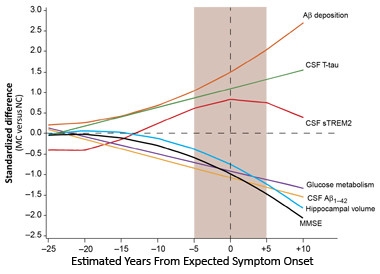Paper Alert: Slotting TREM2 into Alzheimer’s Pathogenesis
Quick Links
Where does TREM2-dependent microglial activity fit into Alzheimer’s pathogenesis? Scientists led by Christian Haass, German Center for Neurodegenerative Diseases (DZNE), Munich, report in the December 14 Science Translational Medicine that it shows up in mid-sequence—after the buildup of Aβ, but around the time CSF tau rises—about five years before symptom onset. The results suggest TREM2-dependent microglial activity revs up relatively early in disease progression in response to initial neuronal injury. Alzforum covered these findings when they were presented at the Alzheimer’s Association International Conference earlier this year (Aug 2016 conference news).

TREM2 in the Middle.
sTREM2 in spinal fluid peaks around the time CSF tau levels are climbing and memory deficits occur. [Courtesy of Science Translational Medicine/AAAS.]
Until now, no one had attempted to plug TREM2-dependent activity into the chronology of biomarker changes in AD. Drawing on samples from the Dominantly Inherited Alzheimer Network (DIAN), which includes mutation-carrying participants destined to develop AD, first author Marc Suárez-Calvet and colleagues took cross-sectional CSF and imaging measurements from 127 carriers and 91 noncarriers. They then compared TREM2 changes relative to other biomarkers in the cascade at different stages of disease.
The authors found that sTREM2 started to creep up in mutation carriers about five years before their expected age at symptom onset, and stayed elevated until about five years afterward. Because the sample of people with advanced disease was small, the authors were cautious about drawing conclusions beyond the five-year mark. However, they clearly saw an uptick in sTREM2 10 years after Aβ began to deposit and around the same time that tau rose.
At the same time, the hippocampus atrophied, glucose metabolism faltered, and cognitive deficits started to appear. In line with these results, sTREM2 levels correlated with total and phosphorylated tau in the CSF, but not Aβ42.
The researchers also saw a modest age-related rise of sTREM2 in controls. That suggests the response is initially beneficial, said Haass. He proposed that TREM2-dependent activity rises in response to tau release, which is elevated in disease. This potentially sends the response into toxic overdrive, he said.
Haass cautioned that these results pertain only to the TREM2-dependent function of microglia. “There may be lots of other microglial functions that are increased at different times in disease,” he said. While sTREM2 is likely too variable to stage disease, it could help track microglial activity in response to BACE1 inhibition or Aβ immunotherapy, said Haass. TREM2-dependent activity itself might become a therapeutic target, he added. Boosting activity early in disease could help microglia eat more plaque, a strategy some scientists are now exploring (see Dec 2016 conference news).—Gwyneth Dickey Zakaib
References
News Citations
Further Reading
Primary Papers
- Suárez-Calvet M, Araque Caballero MÁ, Kleinberger G, Bateman RJ, Fagan AM, Morris JC, Levin J, Danek A, Ewers M, Haass C, Dominantly Inherited Alzheimer Network. Early changes in CSF sTREM2 in dominantly inherited Alzheimer's disease occur after amyloid deposition and neuronal injury. Sci Transl Med. 2016 Dec 14;8(369):369ra178. PubMed.
Annotate
To make an annotation you must Login or Register.

Comments
No Available Comments
Make a Comment
To make a comment you must login or register.